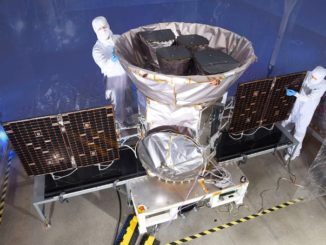
Astronomers have discovered what appears to be an intact, Jupiter-size planet whipping around a compact white dwarf, the remnant of a Sun-like star that exhausted its nuclear fuel and left behind a collapsed core just 40 percent larger than Earth.
The presumed planet, dubbed WD 1856 b, is about seven times larger than the white dwarf, completing one orbit every 34 hours, or more than 60 times faster than Mercury. It is the first intact planet found orbiting a white dwarf, suggesting the possibility, at least, that smaller terrestrial planets also could survive their star’s death.
“WD 1856 b somehow got very close to its white dwarf and managed to stay in one piece,” said Andrew Vanderburg, an assistant professor of astronomy at the University of Wisconsin-Madison and lead author of a paper describing the system in the journal Nature.
“The white dwarf creation process destroys nearby planets, and anything that later gets too close is usually torn apart by the star’s immense gravity,” he said. “We still have many questions about how WD 1856 b arrived at its current location without meeting one of those fates.”
The planet was “found,” orbiting a cool white dwarf 80 light years away, in data collected by NASA’s Transiting Exoplanet Survey Satellite, or TESS, and the agency’s retired Spitzer Space Telescope.
The white dwarf, WD 1856+534, measures about 18,000 kilometres (11,000 miles) across. It was formed when a Sun-like star neared the end of its life and expanded to become a red giant, ultimately blowing off its outer layers. When fusion reactions finally ground to a halt, the core collapsed, cramming much of the star’s mass into a planet-size body.
The Sun is expected to go through this process in about 5 billion years, consuming Mercury, Venus and possibly Earth as it evolves through the red giant phase, eventually leaving a compressed white dwarf behind.
For WD 1856 b to reach its current orbit, it most likely migrated inward over billions of years.
“We’ve known for a long time that after white dwarfs are born, distant small objects such as asteroids and comets can scatter inward towards these stars,” said co-author Siyi Xu, an assistant astronomer at the international Gemini Observatory in Hawaii. “They’re usually pulled apart by a white dwarf’s strong gravity and turn into a debris disk
“That’s why I was so excited when Andrew told me about this system. We’ve seen hints that planets could scatter inward, too, but this appears to be the first time we’ve seen a planet that made the whole journey intact.”
At least two scenarios have been suggested: gravitational interactions with a nearby planet or with a debris disc around the star.
Gravitational interactions between planets are typically chaotic while interactions between a planet and a disc of debris are relatively benign.
“In this case, it’s possible that a debris disc could have formed from ejected material as the star changed from red giant to white dwarf,” said co-author Stephen Kane, a professor of planetary astrophysics at the University of California at Riverside.
“Or, on a more cannibalistic note, the disc could have formed from the debris of other planets that were torn apart by powerful gravitational tides from the white dwarf,” he added. “The disc itself may have long since dissipated.”
In a separate paper published in the Astrophysical Journal Letters, researchers said NASA’s upcoming James Webb Space Telescope will be capable of detecting biosignatures of life on an Earth-like planet found orbiting a white dwarf. As such a planet moves across the small star’s disc as viewed from Earth, spectral analysis of starlight passing through the planet’s atmosphere will be much easier to decipher.
“When observing Earth-like planets orbiting white dwarfs, the James Webb Space Telescope can detect water and carbon dioxide within a matter of hours,” said co-author Ryan MacDonald, a research associate at Cornell University’s Carl Sagan Institute. “Two days of observing time with this powerful telescope would allow the discovery of biosignature gases, such as ozone and methane.”



